2026 FIFA World Cup in the US, Canada and Mexico
The 2026 World Cup will be hosted by the United States, Canada and Mexico. Together they want to offer unity, security and opportunities to the World Cup 2026, football sport, football fans and the world [ref].
| World Cup 2026 | |
|---|---|
| Host country: | Canada, Mexico and the US |
| Date: | June 11 - July 19, 2026 |
| Teams: | 48 |
| Matches: | 104 |
| Host cities: | 16 |
| Stadiums: | 16 |
| Edition: | 23 |
| Champion: | Argentina |
The tournament will be the first to be hosted by three countries and the first World Cup in North America since 1994. This tournament will be the first to feature 48 teams, an expansion of 16 teams from the original 32 participants.
This edition is the 23rd FIFA World Cup, FIFA's quadrennial global football tournament. FIFA believes that a bigger World Football Championship also means a better tournament. Partly due to the expansion of the number of participating countries, the selection process for the allocation of the host country has been tightened.
Table of contents [hide]
? min. reading time | ? words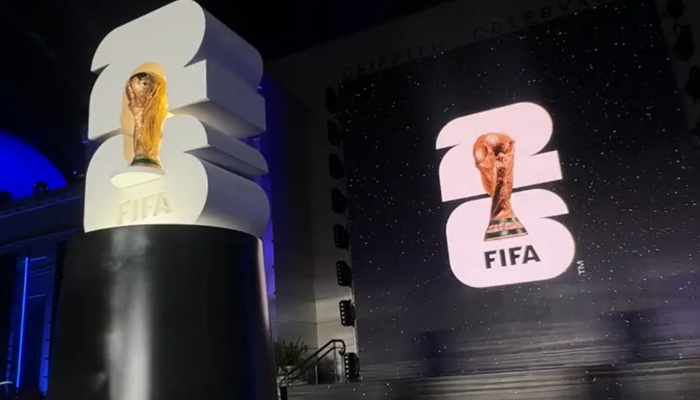
Setup World Cup 2026
The 2026 World Championship has been expanded to 48 participants, so that the schedule consists of 104 matches (instead of 32 participants and 64 matches).
There are 12 groups of 4 countries each, with the numbers 1 and 2 progressing to the knockout rounds, as well as the 8 best numbers 3. This means that the teams reaching the final will now have to play eight matches, instead of seven.
FIFA aims to promote football and wants as many people as possible to participate in the sport towards the 2026 World Cup. Top talent is born every day and in 2026 there will only be more. The combined population of the US, Mexico and Canada is estimated to be 550 million people by 2026.
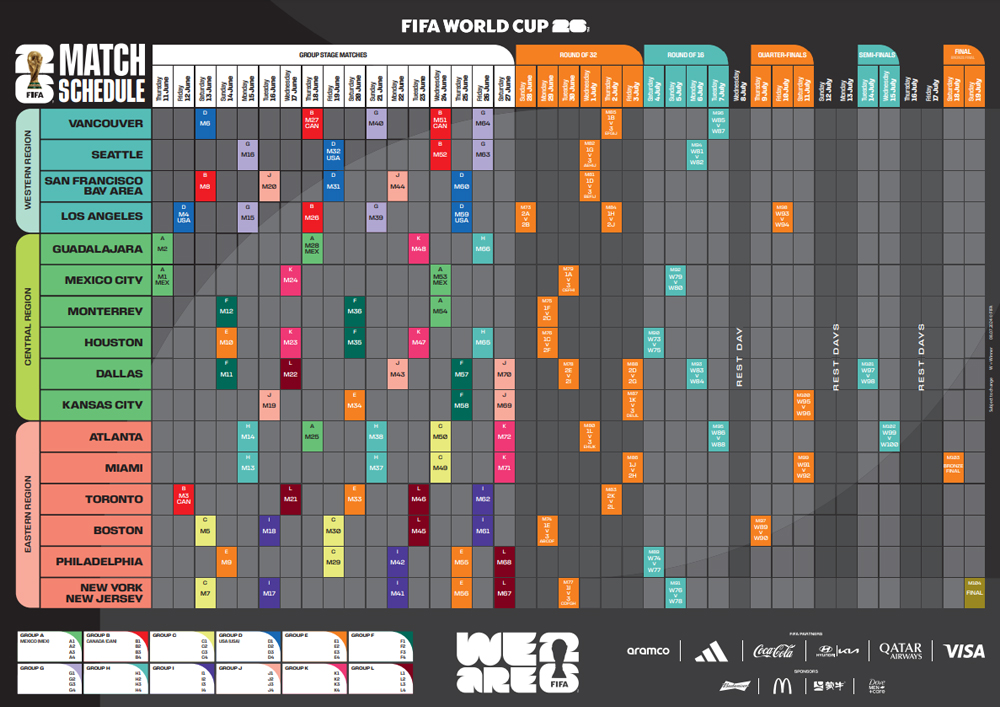
The next FIFA World Cup will once again take place in the usual summer months of June and July. The final is scheduled for Sunday, July 19, while the opening match will be played on Thursday, June 11.
The full schedule was announced on Sunday, February 4, 2024. The organization has selected New York/New Jersey to host the final, while the legendary Estadio Azteca in Mexico City will host the tournament's opening match.
2026 World Cup schedule
The 2026 World Cup schedule includes 104 matches played between 48 teams. The first match takes place on June 11 and the final is scheduled for July 19.
England will play in the group stage on June 17 against Croatia, on June 23 against Ghana, and finally on June 27 against Panama.
| #22) Wed 17 Jun 21:00 | group L | Dallas | ||
| England | 21:00 | Croatia | ||
| #45) Tue 23 Jun 21:00 | group L | Boston | ||
| England | 21:00 | Ghana | ||
| #67) Sat 27 Jun 22:00 | group L | New York/New Jersey | ||
| Panama | 22:00 | England | ||
Groups at the 2026 World Cup
There are 12 groups of 4 teams each at the World Cup. The groups are labeled from A to L, with each group consisting of nations from different continents.
England is in Group L, together with Croatia, Ghana and Panama.
| Group L |
|---|
Host countries of the 2026 World Cup
The 2026 World Cup will be held in Canada, the United States and Mexico. Having previously hosted the 1970 and 1986 tournaments, Mexico will become the first nation to host or co-host the men's World Cup three times. The United States last hosted the men's World Cup in 1994, while this will be the first time Canada has hosted or co-hosted the men's tournament.
- Canada
- Mexico
- United States
Canada has proven its experience in hosting major sporting events. Competitions for women and youth are only getting bigger in the country. The Canadians are at the forefront of human rights and environmental friendliness. They want to use the football tournament to promote economic advancement for their diverse population, promote racial and gender equality, and improve infrastructure.
- Founded: 1867
- Population: 36.7 million
- Area: 9,985,000 km2
- Time zone: UTC -3.5 to -8
- Languages: English and French
Mexico wants to inspire its citizens to go beyond its borders and show future generations that anything is possible. The country has been allowed to organize the World Cup twice before and therefore knows that the tournament is good for the development of a country. Mexico wants to show the world that it is a culturally developed country, with health benefits, equality between citizens and the promotion of an active lifestyle.
- Founded: 1810
- Population: 122 million
- Area: 1,973,000 km2
- Time zone: UTC -5 to -8
- Languages: Spanish
In the United States, the focus on sports and a healthy lifestyle has never been higher. Football is also growing in popularity and more and more people are taking an active part in the sport. The 2026 World Cup is hoped that the spark will spread to the 326 million inhabitants and that football will become even bigger in the country, because the US is the only developed country where football is not the most popular sport. The US has hosted the tournament once before. In 2026, the US will celebrate 250 years of democracy.
- Founded: 1776
- Population: 323 million
- Area: 9,834,000 km2
- Time zone: UTC -4 to -8
- Languages: English
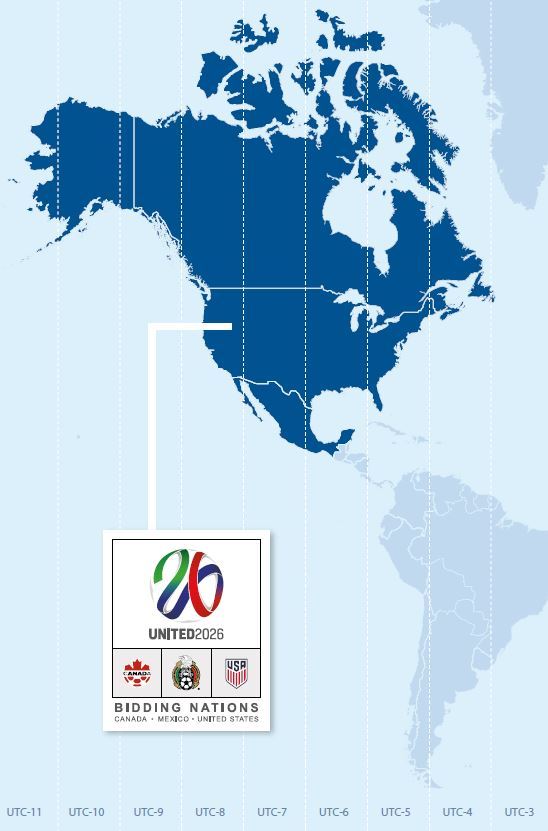
At a time when the countries of the world are being driven apart by political forces, the 2026 World Cup will remind us of the common values and ideals: friendship, mutual respect and unity as people. This is the vision. This is the mission.
Host cities of the 2026 World Cup
For the first time in history, the world's largest football tournament will be hosted by three countries: Canada, Mexico, and the United States. A total of sixteen host cities will host the tournament and host the matches.
Canada
- Toronto
- Vancouver
Mexico
- Guadalajara
- Mexico City
- Monterrey
United States
- Atlanta
- Boston
- Dallas
- Houston
- Kansas City
- Los Angeles
- Miami
- New York New Jersey
- Philadelphia
- San Francisco Bay Area
- Seattle
Stadiums of the 2026 World Cup
A total of sixteen stadiums have been selected as venues – the highest number since Korea/Japan 2002. Each stadium offers an impressive backdrop for the most beautiful football in the world.
Canada
- Toronto Stadium
- BC Place Vancouver
Mexico
- Estadio Azteca, Mexico City
- Estadio Guadalajara
- Estadio Monterrey
United States
- Atlanta Stadium
- Boston Stadium
- Dallas Stadium
- Houston Stadium
- Kansas City Stadium
- Los Angeles Stadium
- Miami Stadium
- New York New Jersey Stadium
- Philadelphia Stadium
- San Francisco Bay Area Stadium
- Seattle Stadium
The host countries all have the necessary football stadiums available, so there is no need to build new arenas. A small number of stadiums are in need of renovation to, among other things, expand the capacity during the World Football Championship.
Official Match Ball of the 2026 World Cup
The adidas TRIONDA was unveiled on 2 October 2025 as the official match ball of the 2026 FIFA World Cup. Its name comes from the Spanish term meaning ‘three waves’, and the vivid design in red, green, and blue pays tribute to the three host nations.
The ball features a brand-new four-panel construction with smooth, flowing lines that echo the movement of waves. Delicate gold details also pay homage to the World Cup Trophy.
Emblems representing each host nation adorn the surface: a maple leaf for Canada, an eagle for Mexico, and a star for the United States.

Mascots of the 2026 World Cup
The three official mascots of the 2026 FIFA World Cup, each representing one of the host countries, were revealed in September 2025.
Maple the moose (Canada), Zayu the jaguar (Mexico), and Clutch the bald eagle (United States) were created to reflect the culture, heritage, and energy of their respective nations.
Together, they stand for unity, diversity, and a shared love for the beautiful game.

Qualification for the 2026 World Cup
The 2026 FIFA World Cup will feature 48 national teams – sixteen more than in previous editions since 1998. The allocation of qualification slots among the continental confederations has already been confirmed:
- AFC (Asia): Eight direct spots + one place through the FIFA Play-Off Tournament
- CAF (Africa): Nine direct spots + one place through the FIFA Play-Off Tournament
- Concacaf (North and Central America and the Caribbean): Six direct spots + two via the FIFA Play-Off Tournament
- CONMEBOL (South America): Six direct spots + one via the FIFA Play-Off Tournament
- OFC (Oceania): One direct spot + one via the FIFA Play-Off Tournament
- UEFA (Europe): Sixteen direct spots
The three host nations – Canada, Mexico and the United States – are already guaranteed participation in the 2026 World Cup. As hosts, they automatically occupy three of the Concacaf qualification places.
Each continental confederation has the autonomy to decide the structure and timing of its own qualifying tournaments.
Allocation World Cup 2026 organization
The 2026 World Cup will be hosted by the United States, Canada and Mexico. The combined bid of the North American football federations has been chosen by the members of FIFA by a majority vote to host the 2026 FIFA World Cup.
210 FIFA members attended the congress, of which 203 countries are eligible to vote.
Votes from the first round of voting [ref]:
- Morocco: 65 votes (33%)
- US, Canada and Mexico: 134 votes (67%)
- None of the bids: 1 vote (1%)
- No choice: 3 votes
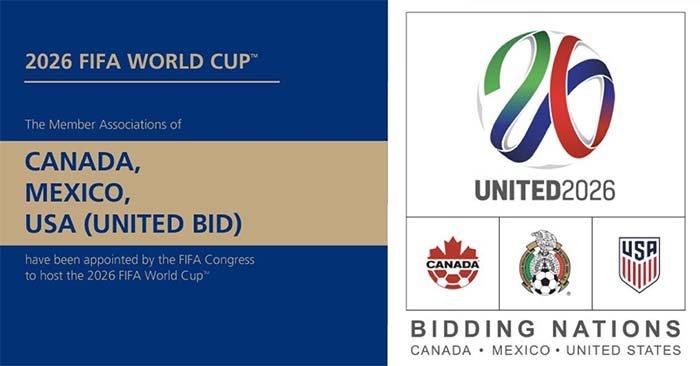
Opportunities and risks of the 2026 World Cup
The risks present in the host countries during the 2026 World Cup have been extensively assessed by FIFA. A distinction is made between technical components (infrastructure and commercial), compliance with laws and regulations, safety and medical affairs, sustainability, human rights and environmental protection.
The table below shows the risks of the 2026 World Cup in the US, Canada and Mexico.
| Technical components (infrastructure and commercial) | |
|---|---|
| Stadiums | Low |
| Team and umpires facilities | Low |
| Accommodations | Low |
| Transportation | Low |
| Accommodations and transportation | Low |
| IT&T and IBC | Low |
| FIFA Fan Fest | Low |
| Organization costs | Medium |
| Media and marketing | Low |
| Ticket sales and tourism | Low |
| Compliance with laws and regulations | |
| Government support | Medium |
| Contracts | Low |
| Security and medical matters | |
| Safety and security | Low |
| Health and medical affairs | Low |
| Volunteers | Low |
| Communication, PR and promotion | Low |
| Related events | Low |
| Sustainability, human rights and environmental protection | |
| Sustainable event management | Low |
| Human rights and labor law | Medium |
| Environmental protection | Low |
The United 2026 bid has the desired level of infrastructure already in place and fully operational, unlike Morocco's bid (the other candidate).
The joint bid of the United States Soccer Federation, the Canadian Soccer Association and the Mexican Football Association has a big advantage in terms of economies of scale for the World Cup with 48 countries.
Because the FIFA World Cup is only held once every 4 years, FIFA wants to show new innovations and developments every tournament. United 2026 is very ahead of that. The host countries can fully invest their energies in sports-related technologies, fan involvement, multimedia interaction and other forms of digitization.
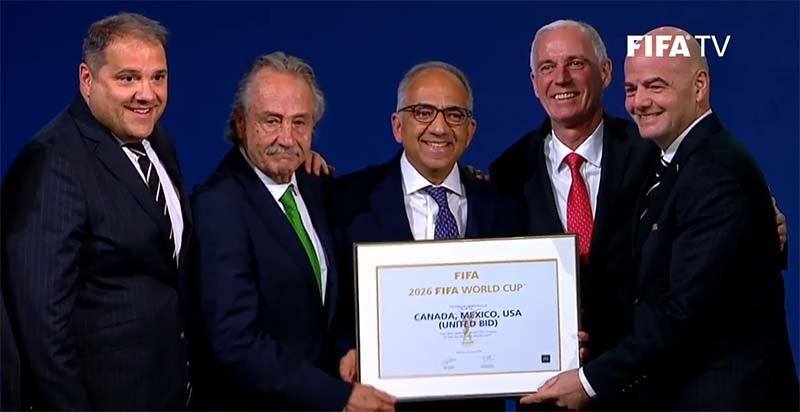
Vision and strategy for the 2026 World Cup: a unified event
The 2026 World Cup will be a historic moment in the world of sport, with Canada, Mexico and the United States as co-hosts. This tournament, with its new expanded format, offers an unprecedented opportunity for these three nations to take football to the next level. This article provides a comprehensive overview of the vision and strategy behind the tournament, with ethics, sustainability and lasting social impact at its core.
With this vision, the 2026 World Cup aims to be more than just a sporting event. It aims to promote football worldwide, making the sport more inclusive, while also advancing key themes such as human rights, sustainability and social inclusion. The strategy for the tournament focuses on four key pillars: the event, the sport, the fans and the world.
The vision for the 2026 World Cup: a sustainable and united event
The organization of the 2026 World Cup follows FIFA’s vision of ethical standards and sustainability. The tournament is not just a sporting endeavor, but a platform for social progress and cultural exchange. The three host countries – Canada, Mexico and the United States – have joined forces to jointly organize this major tournament.
The choice to have three countries working together underlines the importance of cooperation and unity. No country could achieve this on its own, and therefore the shared goal is to organise a tournament of the highest standard. It is an opportunity to open up football to a wider audience and leave a lasting legacy for future generations.
Canada's Role and Vision for the FIFA World Cup
Canada has a proven track record of hosting major international sporting events, including the 2015 Women's World Cup and the 2007 Men's U-20 World Cup. For the 2026 World Cup, the focus will be on uniting the country through football and creating a legacy that will last for generations.
Canada aims to achieve not only sporting success but also social and economic benefits by involving the entire country in the event. The focus is on equality, inclusion and sustainability, with Canada seizing the opportunity to reinforce its status as a leader in human rights and environmental protection.
Key goals for Canada:
- Investing in football through partnerships with local authorities and stakeholders.
- Development of infrastructure and training facilities, such as Team Base Camps, to strengthen the sport in the long term.
- Innovation in men's football by introducing an eight-year performance progression plan.
Mexico's ambition: football as a tool for development
Mexico, which has hosted the World Cup twice before, sees the 2026 World Cup as an opportunity to further develop the country. Football is deeply rooted in Mexican culture, and this tournament provides a platform to share Mexico's rich traditions and social values with the rest of the world.
The aim is not only to host a successful tournament, but also to contribute to broader societal development. The 2026 World Cup is seen as an opportunity to make progress in the areas of public health, gender equality and social inclusion.
Main goals for Mexico:
- To present the country's cultural and social wealth worldwide.
- Celebrating unity and friendship among the three host countries and promoting cooperation.
- To use the tournament to stimulate progress in health promotion and social development, with special attention to young people.
The United States: Soccer Growth and New Opportunities
For the United States, the 2026 World Cup represents a turning point in the growth of soccer within the country. While the game is already growing in popularity, the tournament offers a unique opportunity to further embed the sport in American culture. The tournament is seen as the catalyst for further developing soccer in the U.S., both at the grassroots level and in professional competitions.
The United States aims to attract millions of new players, fans and coaches through this tournament. The tournament’s impact will extend beyond the sports field, with the goal of making soccer more affordable and accessible to all, including underserved communities.
Focus points for the United States:
- Ushering in a new era of football growth, with an emphasis on inclusion and diversity.
- Using the tournament to increase the visibility of football and attract a new generation of football fans.
- Investing in infrastructure and player and coach development at all levels.
Strategy for the 2026 World Cup: United by Football
The strategy behind the 2026 World Cup is based on a unified approach from the three host nations. The tournament will be staged in 16 existing world-class stadiums across Canada, Mexico and the United States. The plan includes playing 10 matches in both Canada and Mexico, while the United States will host 60 matches.
The distribution of matches has been designed to take into account both regional distribution and altitude differences, allowing for optimal performance of players. In addition, attention has been paid to the environmental impact and maximizing the viewing audience, by planning the tournament to reach a global audience.
Key strategy points:
- The health and safety of players and officials will be a priority in all planning.
- Stadiums are already operational and meet all FIFA requirements, so no major public investment is required.
- Training facilities and Team Base Camps are spread across the continent to provide optimal conditions.
The 2026 World Cup presents a unique opportunity for Canada, Mexico and the United States to co-host a historic sporting event. The tournament is more than a sporting spectacle; it is a platform for social progress, cultural exchange and sustainable development. The organization’s vision is to deliver a tournament of the highest standards, with a lasting impact on both sport and society.
With a strong focus on ethics, sustainability and inclusion, the 2026 World Cup will leave a lasting legacy for future generations and contribute to the global growth of football.
Legacy of the 2026 World Cup: A sustainable and economic legacy
The 2026 World Cup will be a historic collaboration between Canada, Mexico and the United States. The tournament is not only a major sporting event, but also an opportunity to create a lasting legacy of sustainability, economic impact and social progress. This article explores how the 2026 World Cup has been designed with a focus on a sustainable future, innovative solutions and inclusive growth, with the aim of strengthening football globally.
A sustainable and united event
The 2026 World Cup is unique in that it will use existing stadiums and infrastructure in the three host countries, without the need to build new facilities. This reduces the environmental footprint of the event and eliminates the risks of large public expenditures that often accompany the construction of new stadiums. The tournament is a model of economic responsibility, with an emphasis on maximizing existing resources.
Characteristics of the sustainable approach:
- Use of existing stadiums instead of building new stadiums.
- No need for large public expenditure on infrastructure.
- Embedding sustainable principles into every aspect of the organization.
The 2026 World Cup organisation aims to go beyond FIFA’s minimum sustainability requirements. Under the banner of “ Sustainability +”, the organisation has committed to a comprehensive approach that encompasses both environmental protection and the promotion of human rights. This strategy is intended to have a lasting impact not only on sport, but also on the communities of the host countries.
Economic impact and benefits
The 2026 World Cup will bring significant economic benefits to the three host countries and their cities. The expected economic impact of the tournament is estimated at over USD 5 billion, resulting in, among other things, the creation of 40,000 jobs and over USD 1 billion in additional labor income for the candidate host cities. This economic activity will boost a wide range of sectors, from tourism to logistics and hospitality.
The main economic benefits are:
- Over $5 billion in economic activity during the tournament.
- Creating 40,000 new jobs in host countries.
- $1 billion in additional labor income for local economies.
In addition, the 2026 World Cup will boost football’s commercial potential, with more than 5.8 million tickets expected to be sold. This activity will help to further grow football in North America and beyond, while also opening the door to new sponsorship opportunities and commercial partnerships for FIFA and the football associations involved.
Innovation and technological progress
The 2026 World Cup will also provide a platform for technological innovation and advancement. The organisation will utilise the latest technologies in logistics, security, medical care and media, enabling the event to be delivered efficiently and effectively. This includes, for example, the use of advanced transport and communication systems to ensure that fans, players and officials can move seamlessly between the host cities.
The host nations are leaders in technological advancements, and this innovation will also be visible during the tournament. The integration of smart cities, sustainable energy solutions and technological improvements in the stadiums and training facilities will contribute to the flawless execution of the event.
Examples of innovation during the 2026 World Cup:
- Advanced transportation systems and smart city solutions to optimize travel.
- Use of sustainable energy in stadiums and training facilities.
- Innovative safety technologies and medical care for players and spectators.
Social impact and inclusion
One of the main pillars of the 2026 World Cup is the focus on social impact and inclusion. The organization aims to make football more accessible to everyone, regardless of background, gender or social status. This is done by creating safe playing environments, promoting gender equality and increasing access to football for disadvantaged communities.
The organization has developed a comprehensive strategy to promote the sport among women and girls, and to support underprivileged communities in developing football facilities and programs. These initiatives will have a positive impact on society not only during the tournament, but also long after.
Key social goals of the 2026 World Cup:
- Promoting gender equality and supporting women in football.
- Creating safe playing environments by constructing 2,026 mini fields in North America.
- Involving disadvantaged communities in football development programs.
In addition, the organization is working with FIFA and local governments to develop best practices for integrating football into education and health programs. The 2026 World Cup offers a unique opportunity to use football as a tool for social change and to promote well-being within the communities of the host countries.
Legacy and future-oriented inheritance
The greatest legacy of the 2026 World Cup will be its sustainable and inclusive approach, which will have a lasting positive impact on the communities in the host countries. By investing in existing infrastructure, innovative technologies and social programs, the tournament will leave a legacy that extends beyond football.
The organization has developed a long-term strategy focused on ensuring the health of the sport, growing its fan base and driving economic growth through football. This approach will not only benefit North America, but also provide a model for future World Cup host nations.
The 2026 World Cup is not only a major sporting event, but also an opportunity to create a lasting, positive legacy in terms of sustainability, economic benefits and social progress. The partnership between Canada, Mexico and the United States offers a unique model for an economically responsible and sustainable tournament, making football more accessible to a wider audience. With a strong focus on innovation, inclusion and economic impact, the 2026 World Cup will be a model for future sporting events worldwide.
Political support and acceptance for the 2026 World Cup
The 2026 World Cup, hosted by Canada, the United States and Mexico, enjoys broad political support and buy-in in all three countries. This article discusses how the governments of these countries have pledged their political support and the impact this has on the organisation of the tournament. It also highlights the visions of each country, focusing on the economic benefits, social impact and promotion of sport.
Political support and shared vision
The governments of Canada, the United States and Mexico have jointly developed a vision for the 2026 World Cup. This vision underscores how great events can create lasting legacies that benefit not only individuals and communities, but also the nation as a whole. The three countries emphasize their shared values of freedom, equality and opportunity, and see the World Cup as an opportunity to promote these ideals both domestically and internationally.
The organization of the first World Cup with 48 participating countries is seen as an example for future organizers. By using existing infrastructure and stadiums, the resources saved can be used to develop football at all levels in North America. This strategy ensures both political and public support and broad acceptance for the tournament.
Canada: diversity and sports development
Canada has a proven track record of hosting major sporting events, including the 2015 Women’s World Cup. The Canadian government sees the 2026 World Cup as a catalyst for the continued growth of men’s football in the country. The tournament also provides an opportunity to celebrate the country’s diversity, as a large portion of Canada’s population is of foreign descent. This diversity is a major strength of the country and is celebrated as such at global events such as the World Cup.
Canada's key points:
- Stimulating the growth of football among young people.
- Promoting diversity and inclusion through sport.
- Promoting gender equality and human rights during the tournament.
In addition, Canada sees the 2026 World Cup as an opportunity to promote physical activity among its citizens. Sport plays an important role in the health and well-being of the population, and a major event like the World Cup can serve as an inspiration for Canadians to become more active.
Mexico: Economic Opportunities and Sustainability
For Mexico, football is a central part of its culture and national identity. The 2026 World Cup offers a unique opportunity to boost the economy and create new opportunities for the Mexican people. The Mexican government sees the tournament as a means to create jobs, increase economic activity and provide a platform for education and collaboration with international experts in the fields of media and technology.
Mexico's priorities:
- Stimulating economic growth through new jobs and collaboration opportunities.
- Promoting sustainability and environmental protection during the tournament.
- Strengthening human rights and social justice, with special attention to youth.
Mexico has also committed to promoting sustainability during the 2026 World Cup, working with Canada and the United States to minimize the tournament’s carbon footprint. Mexico is committed to green solutions, such as reducing pollution and waste, and will use the tournament as an opportunity to raise environmental awareness.
United States: Security and Economic Progress
The United States, one of the three host countries, has a strong focus on promoting economic opportunity and security during the 2026 World Cup. The U.S. government sees the tournament as an opportunity to increase employment and contribute to the country’s economic growth. Providing a safe and secure event is a top priority, with measures aimed at ensuring the safety of both residents and visitors.
Key points for the US:
- Promoting employment and economic opportunities for American citizens.
- Ensuring safety and security during the tournament.
- Promoting a healthy and active lifestyle for all ages.
In addition, the 2026 World Cup will help promote an active lifestyle among Americans. The tournament will inspire physical activity and health, especially for young people, and encourage them to participate in sports and recreation.
The 2026 World Cup is supported by broad political and public support in Canada, Mexico and the United States. The governments of these countries see the tournament as an opportunity to promote not only football, but also economic growth, social inclusion and sustainability. With a strong focus on safety, human rights and environmental responsibility, the 2026 World Cup will have a lasting 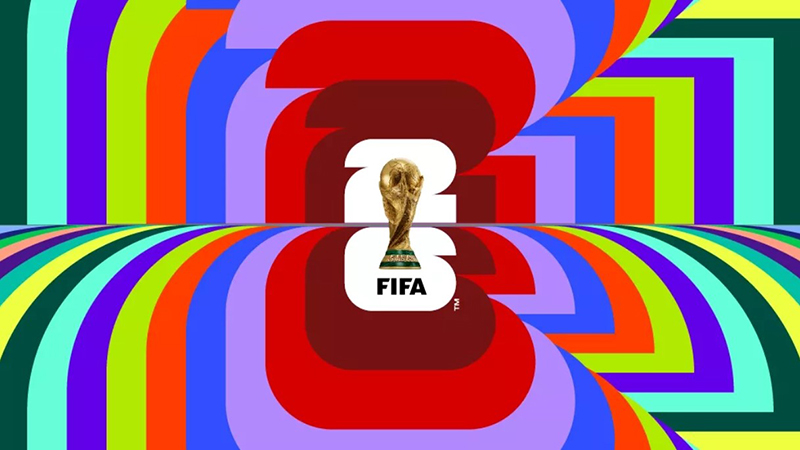
Official name of the 2026 Football World Cup
The 2026 FIFA World Cup has different official names:
- FIFA World Cup 26™
- FIFA World Cup™
- Copa Mundial de la FIFA 26™
- Copa Mundial de la FIFA™
- Coupe du Monde de la FIFA 26™
- Coupe du Monde de la FIFA™
- World Cup 26™
- World Cup™
- FIFA®
- COPA MUNDIAL™
- COUPE DU MONDE™
- MUNDIAL™
World Cup 2026 frequently asked questions (FAQ)
When will the 2026 World Cup be held?
Where will the 2026 World Cup be held?
References
[hide]Share
Share this message via social media with your family, friends and colleagues!
Football World Cup 2026: schedule, groups, qualification, host cities and stadiums. Everything about the World Cup 2026 in the US, Canada and Mexico.
About the author

Author of this content is Patrick. I have been playing soccer for more than 25 years and follow the daily news closely. My hobbies include playing football, running and maintaining various websites, in addition to my job as a financial professional.
I do not work for any related company or institution, so the information is reliable and independent. The information has been collected accurately from reliable sources and is regularly updated.
